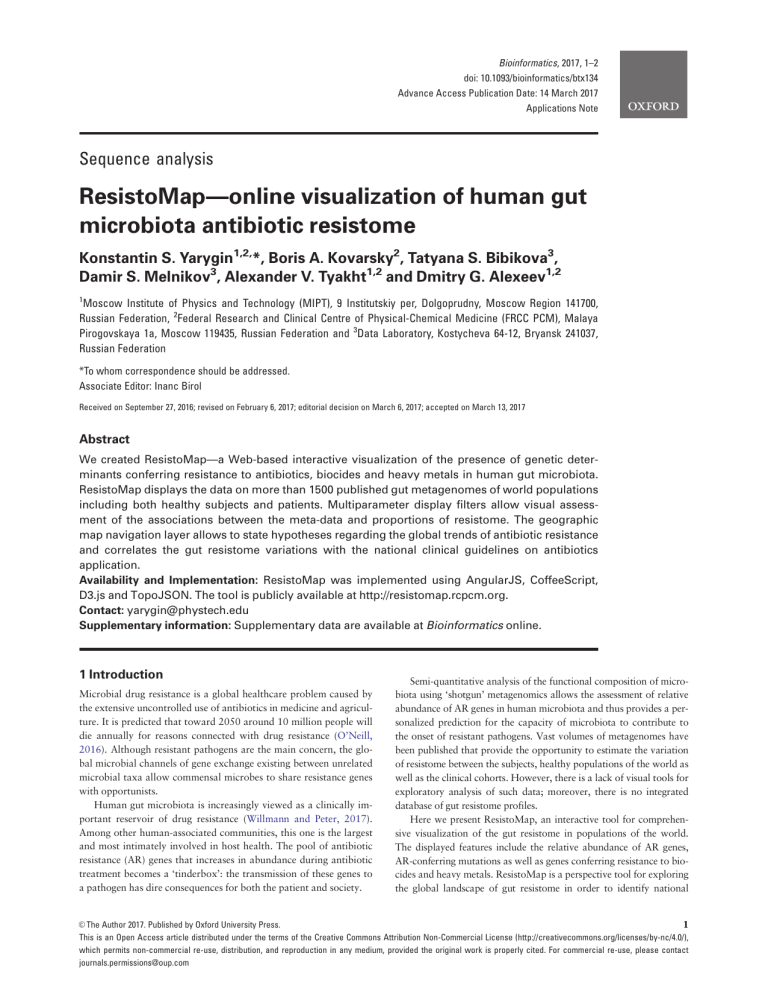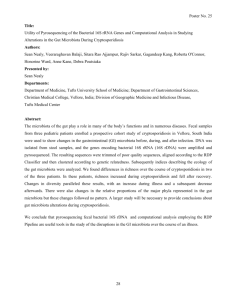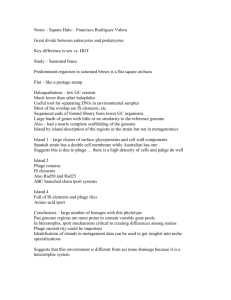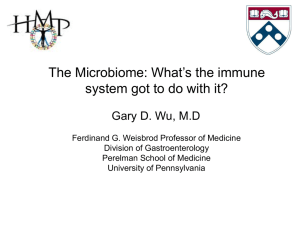ResistoMap: Online Visualization of Gut Microbiota Antibiotic Resistance
advertisement

Bioinformatics, 2017, 1–2 doi: 10.1093/bioinformatics/btx134 Advance Access Publication Date: 14 March 2017 Applications Note Sequence analysis ResistoMap—online visualization of human gut microbiota antibiotic resistome Konstantin S. Yarygin1,2,*, Boris A. Kovarsky2, Tatyana S. Bibikova3, Damir S. Melnikov3, Alexander V. Tyakht1,2 and Dmitry G. Alexeev1,2 1 Moscow Institute of Physics and Technology (MIPT), 9 Institutskiy per, Dolgoprudny, Moscow Region 141700, Russian Federation, 2Federal Research and Clinical Centre of Physical-Chemical Medicine (FRCC PCM), Malaya Pirogovskaya 1a, Moscow 119435, Russian Federation and 3Data Laboratory, Kostycheva 64-12, Bryansk 241037, Russian Federation *To whom correspondence should be addressed. Associate Editor: Inanc Birol Received on September 27, 2016; revised on February 6, 2017; editorial decision on March 6, 2017; accepted on March 13, 2017 Abstract We created ResistoMap—a Web-based interactive visualization of the presence of genetic determinants conferring resistance to antibiotics, biocides and heavy metals in human gut microbiota. ResistoMap displays the data on more than 1500 published gut metagenomes of world populations including both healthy subjects and patients. Multiparameter display filters allow visual assessment of the associations between the meta-data and proportions of resistome. The geographic map navigation layer allows to state hypotheses regarding the global trends of antibiotic resistance and correlates the gut resistome variations with the national clinical guidelines on antibiotics application. Availability and Implementation: ResistoMap was implemented using AngularJS, CoffeeScript, D3.js and TopoJSON. The tool is publicly available at http://resistomap.rcpcm.org. Contact: yarygin@phystech.edu Supplementary information: Supplementary data are available at Bioinformatics online. 1 Introduction Microbial drug resistance is a global healthcare problem caused by the extensive uncontrolled use of antibiotics in medicine and agriculture. It is predicted that toward 2050 around 10 million people will die annually for reasons connected with drug resistance (O’Neill, 2016). Although resistant pathogens are the main concern, the global microbial channels of gene exchange existing between unrelated microbial taxa allow commensal microbes to share resistance genes with opportunists. Human gut microbiota is increasingly viewed as a clinically important reservoir of drug resistance (Willmann and Peter, 2017). Among other human-associated communities, this one is the largest and most intimately involved in host health. The pool of antibiotic resistance (AR) genes that increases in abundance during antibiotic treatment becomes a ‘tinderbox’: the transmission of these genes to a pathogen has dire consequences for both the patient and society. C The Author 2017. Published by Oxford University Press. V Semi-quantitative analysis of the functional composition of microbiota using ‘shotgun’ metagenomics allows the assessment of relative abundance of AR genes in human microbiota and thus provides a personalized prediction for the capacity of microbiota to contribute to the onset of resistant pathogens. Vast volumes of metagenomes have been published that provide the opportunity to estimate the variation of resistome between the subjects, healthy populations of the world as well as the clinical cohorts. However, there is a lack of visual tools for exploratory analysis of such data; moreover, there is no integrated database of gut resistome profiles. Here we present ResistoMap, an interactive tool for comprehensive visualization of the gut resistome in populations of the world. The displayed features include the relative abundance of AR genes, AR-conferring mutations as well as genes conferring resistance to biocides and heavy metals. ResistoMap is a perspective tool for exploring the global landscape of gut resistome in order to identify national 1 This is an Open Access article distributed under the terms of the Creative Commons Attribution Non-Commercial License (http://creativecommons.org/licenses/by-nc/4.0/), which permits non-commercial re-use, distribution, and reproduction in any medium, provided the original work is properly cited. For commercial re-use, please contact journals.permissions@oup.com 2 K.S.Yarygin et al. traits in antibiotic intake, correlating the resistome composition with various external factors and generate biomedical hypotheses that can help to control the drug resistance on a global scale. 2.3 User contributions 2 Implementation 3 Data processing 2.1 Navigation The relative abundance of resistance-conferring genes was evaluated by mapping the metagenomic reads to the CARD database v.1.0.5 (McArthur et al., 2013) and normalizing the gene coverage. The potential resistance-conferring mutations were analyzed using the published list of such mutations (Elbehery et al., 2016) and PATRIC database (Wattam et al., 2013). The levels of resistance to heavy metals and biocides were assessed using the BacMet database (Pal et al., 2014). Details of these steps are described in the Supplementary Data. ResistoMap contains two main interactive work fields—a geographic map and a heatmap. The heatmap displays the median relative levels of determinants conferring resistance to each of the antibiotic groups (columns) in each selected cohort of subjects (rows). The values were precomputed by classifying the gut metagenomic reads from 12 publicly available studies (see section 2.2). The number of metagenomes included in the cohort is displayed on the left from the heatmap below the colour key. The heatmap contains four vertical sections corresponding to different types of resistome quantification: 1. 2. 3. 4. levels of AR-conferring genes levels of mutations in target genes levels of genes conferring resistance to biocides (total) levels of genes conferring resistance to heavy metal (total) Using the drop-down lists at the top of the screen, users can choose the antibiotic group of interest, the study(-ies) and/or the country (-ies) to be displayed on the heatmap. To filter the cohort, users can use ‘Pool by’ checkboxes that allow the stratification of cohorts by country of origin, gender, age and diagnosis (where applicable). It is possible to sort the rows of the heatmap by the number of samples and resistance level (by mean value or a selected antibiotic). For convenience of comparison between close values, clicking on a cell ‘freezes’/‘unfreezes’ the displayed abundance value on the right. 2.2 Metagenomic data The datasets for the analysis of resistome included 1593 gut metagenomes from the individuals from 12 studies covering 15 countries (Clemente et al., 2015; Consortium et al., 2012; Karlsson et al., 2013; Nielsen et al., 2014; Nishijima et al., 2016; ObregonTito et al., 2015; Qin et al., 2012; Rampelli et al., 2015; Tyakht et al., 2013; Yap et al., 2013; Zeevi et al., 2015; Zeller et al., 2014). For each metagenome, additional factors including country of origin, gender, age and clinical status were considered (where available). Using ResistoMap, one can estimate the global landscape of resistance potential to different groups of antibiotics as well as infer associations between specific drugs and clinical meta-data. It is important to provide a diverse reference database of the resistance genes in order to draw adequate conclusions from metagenomic data; such databases are constantly expanding, and already, using current data we have discovered a number of interesting patterns, some of which are in agreement with available epidemiological data while others are non-intuitive and await interpretations from a clinical perspective (see Supplementary Material). Although the precision of the resistome profile comparison between different studies may be limited due to variations in sample preparation protocols, the exploratory analysis of global gut resistome using ResistoMap shows global trends that will gain new insights and contribute to the spread of antibiotic stewardship and rational use of antimicrobial substances in agriculture. It is possible to contribute published datasets to ResistoMap by following the instructions on the site (“Add your data” button). Funding This work was supported by the Russian Scientific Foundation [grant number 15-14-00066]. Conflict of Interest: none declared. References Clemente,J.C. et al. (2015) The microbiome of uncontacted Amerindians. Sci. Adv., 1, e1500183. Consortium,H.M.P. et al. (2012) Structure, function and diversity of the healthy human microbiome. Nature, 486, 207–214. Elbehery,A.H. et al. (2016) Antibiotic resistome: Improving detection and quantification accuracy for comparative metagenomics. Omics, 20, 229–238. Karlsson,F.H. et al. (2013) Gut metagenome in European women with normal, impaired and diabetic glucose control. Nature, 498, 99–103. McArthur,A.G. et al. (2013) The comprehensive antibiotic resistance database. Antimicrobial Agents and Chemotherapy, 57, 3348–3357. Nielsen,H.B. et al. (2014) Identification and assembly of genomes and genetic elements in complex metagenomic samples without using reference genomes. Nat. Biotechnol., 32, 822–828. Nishijima,S. et al. (2016) The gut microbiome of healthy Japanese and its microbial and functional uniqueness. DNA Res., 23, 125–133. Obregon-Tito,A.J. et al. (2015) Subsistence strategies in traditional societies distinguish gut microbiomes. Nat. Commun., 6, 6505. O’Neill,J. (2016). Tackling Drug-Resistant Infections Globally: final Report and Recommendations. London: Wellcome Trust & HM Government. Pal,C. et al. (2014) BacMet: antibacterial biocide and metal resistance genes database. Nucleic Acids Res., 42, D737–D743. Qin,J. et al. (2012) A metagenome-wide association study of gut microbiota in type 2 diabetes. Nature, 490, 55–60. Rampelli,S. et al. (2015) Metagenome sequencing of the Hadza huntergatherer gut microbiota. Curr. Biol., 25, 1682–1693. Tyakht,A.V. et al. (2013) Human gut microbiota community structures in urban and rural populations in Russia. Nat. Commun., 4, Wattam,A.R. et al. (2013) PATRIC, the bacterial bioinformatics database and analysis resource. Nucleic Acids Res, 42, D581–D591. Willmann,M. and Peter,S. (2017) Translational metagenomics and the human resistome: confronting the menace of the new millennium. J. Mol. Med. (Berl.), 95, 41–51. Yap,G. et al. (2013). Comparative evaluation of the bacterial gene composition of stool microbiota in infants with and without eczema preliminary findings. In: Allergy. Vol. 68. Wiley-Blackwell, NJ USA, 706–706. Zeevi,D. et al. (2015) Personalized nutrition by prediction of glycemic responses. Cell, 163, 1079–1094. Zeller,G. et al. (2014) Potential of fecal microbiota for early-stage detection of colorectal cancer. Mol. Syst. Biol., 10, 766.


